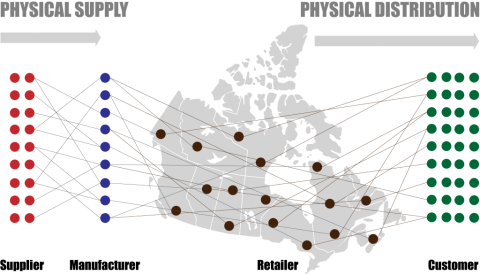
Over the last few decades, small and medium size (SME) companies have been leveraging their daily and long-term operations by using more efficient supply chain delivery and optimization techniques. Business-to-business (B2B) and business-to-customer (B2C) companies are also following this trend to step their game up and deliver their goods and services by shorter production and delivery times. Logistics is one of the critical subjects for e-commerce companies. In a sense, logistics refers to the art of managing the flow of materials to deliver the product to the customers. Throughout the process of designing, manufacturing and delivering the product, companies can utilize their logistics activities within –and certainly not limited to- two domains.
Physical supply Physical supply refers to the portion of logistics that covers activities to deliver the product-related materials to the suppliers.
Physical distribution Physical distribution is the part where the company plans the delivery of the final product to the customers.
Supply chain management has come a long way to overcome a variety of challenges related to logistics. Today’s enterprise management and planning solutions are helping most e-commerce companies to make better decisions, reduce the physical supply and physical distribution costs and improve the overall efficiency of the material flow. Although B2B companies benefit from the sophisticated and automated procedures and estimations more than B2C companies do, there are indeed real-life success stories that can help us to understand the importance of logistics in supply chain management. Home Depot is one of the biggest retailers selling home improvement and construction products and services. With more than 355,000 employees and 2,000 superstores across the US, Canada, Mexico and China, the company is doing pretty well with its efficient supply chain and logistics strategies. The company is also investing heavily in its e-commerce strategies to increase its customer base and become accessible to more customers regardless of their physical location and accessibility to physical stores. Forbes has shared some insights about the company’s e-commerce strategies, which also aligned perfectly with its logistics strategies. One solid example is the way Home Depot operates its inventory and replenishment (I&R) activities for its stores. The company used to have separate logistics management departments in every single physical store to utilize replenishment and store management-related activities. This was costly, as each store had to process the replenishment orders to get the required materials from the suppliers. After realizing that the de-centralization of the logistics management was indeed an issue, Home Depot decided to centralize those individual departments as one in its corporate headquarters. With the help of technology and right software solutions, Home Depot’s new centralized inventory and replenishment (I&R) department created a significant benefit for the company. The overall performance of the department improved the demand forecast accuracy and decreased the cost of operations for the replenishment orders. As a single/centralized department manages the inventory for all stores, the new method increased the bargaining power for the company against the suppliers. As a company, Home Depot was also able to benefit from this change, as it is now able to process online orders more efficiently. Many other e-commerce companies found their own logistics and supply chain management struggles, and were able to overcome those issues by using the right solution. For those companies, different challenges started to get costly depending on various ranges or conditions like the industry, geographical location, corporate culture and structure, and their overall vision about adapting to the changes in demand. By adopting the right solution to manage, plan and deliver, today’s technology can help e-commerce companies improve the overall efficiency and effectiveness of their supply chain-related strategies. These companies need to follow the latest trends in their own supply chain and adopt efficient solutions to survive, compete and improve. There are certainly different variations of solutions out there, and some of them work more efficiently and effectively. Understanding the business problem and analyzing the requirements to overcome that problem is also as important as the adopted solution. Just like Home Depot, many other small, medium and large enterprises are finding their way to optimize their actions and processes with more efficient and effective logistics and supply chain management strategies. As the barriers to entry for startup companies and SMEs go down with the accessibility of e-commerce technologies, more companies are finding ways to survive and improve. Can you name a few more examples of e-commerce companies that have overcome their struggles with efficient logistics and supply chain strategies? Let us know in the comments area.
Additional Resources
- Supply chain management frequently asked questions





